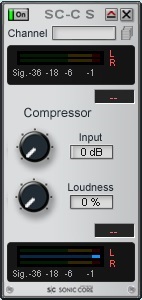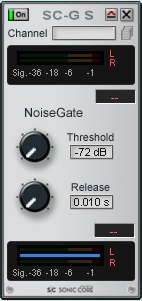![]()
 |
There are three variations of device in this suite consisting of the SC-C S, the SC-G S and the SC-GC S as follows:
In practical use, I found the combination device SC-GC S very useful on input vocal signals, as the gate would eliminate much microphone noise between vocal phrases, and the compressor would even out the dynamic range making the overall volume of the vocal more consistent and easier to mix. Of course, compression can be done post recording in the mix as well. |
 |
||
 |
GaryB: Many of the greatest compressors worked like SC-C S. Some were optical using a light and sensor as the detection circuit. others like the dBx 'over easy' compressors used an electronic circuit to raise compression as the level increased. The way you use it is that you hit it as hard as needed to get the effect that you want (raise the input until you like the way it acts) then you add make up gain to return the level to the level of the bypassed signal. More input equals more compression and longer release times. In fact this is the generally 'correct' way to use a compressor. That is, get the action you want and then match the general level to the level of the bypassed signal. To get effects like pumping or ducking, you can raise the loudness level above the original source or below the level of the original source. The idea is to reduce the difference between the loudest and quietest sounds in a recording. This is because live sound has a dynamic range (the difference between the loudest and quietest sounds that are made) of about 140dB. At best the speakers and stereos most people listen to can reproduce 90dB dynamic range. What that means is that with very dynamic material the quietest sounds disappear or if the quietest sounds are hearable the loud sounds are totally distorted. In a mix the quiet parts of a performance might get drowned by less dynamic parts. |
|||
GaryB: By limiting or compressing a track it is possible to raise its overall level without raising the peak since the difference between the loudest and quietest sounds is reduced. If the quiet sounds are at hearable level but the loudest sounds can be reduced below the level of distortion then the playback system can reproduce the recording and everything can be heard. The way the reduction happens is that an amplifier is controlled by a detector circuit. The detector measures the level of the signal and then every time the signal goes over a chosen threshold the amplifier is turned down a chosen percentage (ratio). In the case of the SC-C S compressor there is no threshold control as it is preset. As the input is raised or lowered more or less of the signal will be over the threshold. In this compressor there is no ratio control. More signal equates to more ratio according to an algorithm. Many compressors have an adjustable attack and release control over their action. This compressor does not.
Eanna: This is basically similar to an LA2A. The Input drives the side-chain circuit to the VCA, affecting the Gain Reduction. The output 'loudness' is the Makeup Gain, boosting the overall signal leaving the device. There isn't any Ratio setting here - but I imagine that the Input knob affects the Ratio as well the Threshold, and effectively the Release too. DBX 'overeasy' is basically a soft-knee curve for the Ratio. The higher the input gain, the more aggressive the ratio / gain reduction in and around the threshold. This effectively smooth's out the Gain Reduction noticeably kicking in. This could indeed be part of the algorithm they've implemented.
|
Dante, GaryB and Eanna October 2013 |
|
|